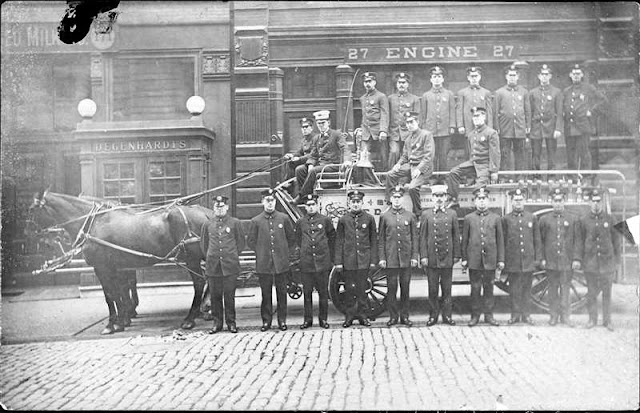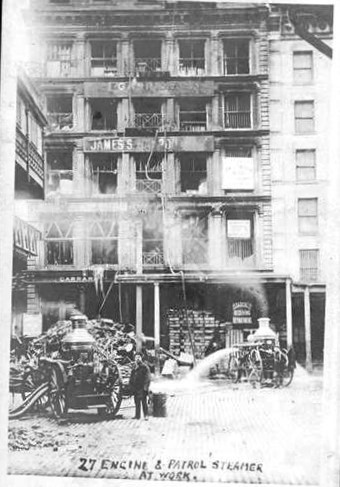
Tootsy was the beloved feline firefighter of Engine Company 27 on Franklin Street in Lower Manhattan. Born on the Fourth of July in 1895, Tootsy reportedly loved the smell of smoke as much as she treasured a fresh-caught mouse.
She was a genuine fire cat who loved riding on the fire engine, conversing with the firemen, and sleeping in her favorite horse’s harness. She was also quite beautiful, and drew much praise from the public and the press when she appeared in the National Cat Show at Madison Square Garden. According to the New York Press, the firemen adored Tootsy so much, they would have rather parted with their shields than lose their “white-fleeced feline fire fighter.”
Tootsy was born in the stall of Old Babe, a veteran fire horse who had joined the engine company 20 years earlier. Her mother cat was also a veteran of the firehouse; she joined Engine Company 27 in 1891 when she was a kitten.
Tootsy was a bit shy of the horses, but she loved and trusted Babe, who had always been her mother’s ally. Babe’s bright harness caught the young Tootsy’s fancy, and from the time she was six weeks old, it served as her “boudoir and reception room.” Only when Babe had to don the harness to respond to a call would Tootsy retire to the desk of the house watchman.

As a kitten, Tootsy had a reckless, dare-devil spirit. She would have responded to every alarm had the firemen allowed her to join them. Sliding down the brass pole from the third floor to the apparatus floor was second nature to her. Once she was on the apparatus floor, it took all the efforts of the firemen to keep her off the engines and tender before they swung out of quarters.
Tootsy’s persistence paid off one cold winter evening in 1895. According to the story reported in the New York Press, everyone in the company except Tootsy and the night watchman had been asleep upstairs when, a few minutes before midnight, the network of wires and bells broke the silence. “Tootsy saw Babe come galloping toward the harness, and the fierce light of a new resolve came into her eyes and she cleared away for action, and with one bound she landed safely on the pipe on the right-hand side of the engine. She lay close to the big boiler, so that the firemen could not see her.”
As the engine dashed down Franklin Street and rattled over the paving stones, Tootsy held fast to the suction pipe. At one point, Captain Robert R. Farrell saw a man point excitedly in the direction of the driver. He leaned over and caught site of Tootsy, who had just been confronted by the engineer.
The young cat then hopped playfully around the engine, “as though she were in quarters rather than traveling 20 miles an hour on a fire engine with a full head of steam on.” Fearing that she would get lost at the fire, Captain Farrell grabbed the fire cat, opened his coat, and tucked her inside. At the fire scene, he handed Tootsy over to Fireman McCoy, who allowed her to stay on the engine as the men fought the blaze on West Broadway.
Although Tootsy tried to respond to other fires, her efforts were almost always thwarted by her mama cat, who would betray the kitten by meowing whenever she saw Tootsy on the engine’s suction pipe. Despite her mother cat’s efforts, Tootsy was determined to make one more fire run on the engine.

Her chance came one snowy night when a second alarm came in for a fire on Broadway. (Engine Company 27 was a two-alarm station, which meant they only responded to the second call. As a two-alarm station, the company’s horses had to remain hitched up long enough for the first officer arriving on the scene to sound a second alarm if needed.)
As was reported in the Press, “Tootsy was dying to get into Broadway, where she could show herself to advantage. She had never been in Broadway, and then she knew that Commissioner Sheffield usually responded to second alarms and she resolved to see the young commissioner, or forfeit one of her nine feline lives in the attempt.”
Two minutes after the first alarm was received, “the gong began its song of danger the second time.” As the company moved out into the street, the firemen looked back and saw a white cat sound asleep in the station. Thinking it was Tootsy, and not her pregnant mama cat, the men decided it was safe to pull out of quarters.
Tootsy saw her window of opportunity and leaped to the suction pipe as the engine started to move. The firemen didn’t see the stowaway feline until they had reached Canal Street. Tootsy balanced herself on the pipe like a tightrope walker as the engine raced to the scene. There, she kept company with the engineer, meowed at the crowd, and kept a close watch on Commissioner James Rockwell Sheffield and Chief Hugh Bonner (they were both reportedly too busy to notice her green eyes riveted on them).
Back at headquarters, Tootsy got a reprimand from Captain Farrell. From that day on, she obeyed his orders and stayed at the firehouse with her mother to care for her younger siblings. To be sure, she still loved sliding down the brass pole, but she never rode to another fire.
I don’t know when she died, but if she passed before 1904, it must have been a sad day for the firemen. As one reporter noted in 1896: “When Tootsy dies there will be sorrow of the genuine kind in the engine house of No. 27.”
A Fatal Fire for Engine Company 27

If Tootsy did not die before 1904, she would have been the one to know great sorrow.
On March 26, 1904, all of the men of Engine Company 27 were disabled and nine men were sent to the hospital in critical condition after falling unconscious during a fire at Charles Plunkett’s broom factory at 205 Duane Street. The factory occupied four floors and the basement of the five-story building. Chemicals used to make the brooms created the lethal fumes.
According to a report of the incident in the Evening World, by the time a second fire company responded, the men of Engine Company 27 were all inside, unconscious or dead. “As they climbed through the smoke from the windows they were overcome and fell insensible into the arms of their comrades, who waited on the street to catch them as they fell.”
Only 30-year-old fireman Thomas McGirr was pulled out alive, but he was not expected to survive. McGirr was at that time the only original member of the company, “all of his old comrades having met death in the past three years.”
A Brief History of Engine Company No. 27
The Metropolitan Steam Engine Company No. 27 was organized on October 16, 1865. Prior to transitioning to the paid fire department, the engine company was known as North River Engine Company No. 30 under the city’s volunteer fire department.

North River was organized on July 15, 1858, by B.F. Grant, William F. Searing, William McGrew, and other volunteers from Eureka Hose Company No. 54. The company was originally headquartered at 153 Franklin Street, but in June 1861 the company moved into a three-story brick house at 173 Franklin Street, which the city had purchased from Andrew Clarke and his wife for $12,500.

The men continued to occupy the old North River firehouse at 173 Franklin Street until May 1881, which is when the city began accepting proposals to erect a new firehouse at the same location. The firemen relocated to 304 Washington Street while Napoleon LeBrun & Son, the fire department’s official architect from 1879 to 1895, designed their new home.
Napoleon Eugene Henry Charles LeBrun and his son Pierre followed their traditional firehouse layout, which included centered bay doors set within a cast-iron base and two upper floors faced in red brick and trimmed in terra-cotta and stone.
The building was decommissioned as a firehouse when the engine company disbanded on November 22, 1975, and was reverted to a welding shop soon thereafter. However, some of features that date back to the days of Tootsy’s sovereignty remain, including an embellished iron lintel over the apparatus entrance, several wood sash windows, and a foliate frieze above the third-story windows.
If you enjoyed this story, you may enjoy reading about the three little kittens the men of Engine Company No. 27 rescued in 1928.

Tootsy is one of the many cats featured in The Cat Men of Gotham: Tales of Feline Friendships in Old New York. If you are interested in obtaining an autographed copy of the book, please contact me at pgavan@optonline.net.



